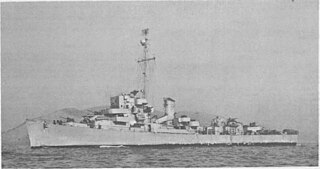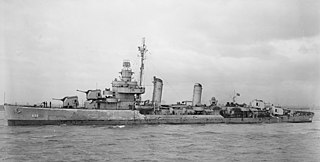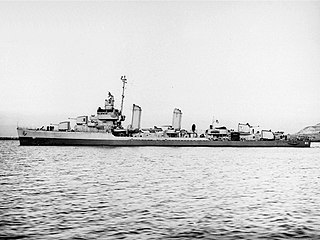
USS Kephart (DE-207/APD-61) was a Buckley-class destroyer escort in service with the United States Navy from 1944 to 1947. After spending 20 years in reserve, she was transferred to Republic of Korea Navy and served another 18 years as Kyong Puk (PF-82) until she was struck in 1985.

USS Howard (DD–179), (DMS-7) was a Wickes-class destroyer in the United States Navy during World War II. She was named for Charles W. Howard, who was killed in the American Civil War aboard USS New Ironsides.

USS Goldsborough (DD-188/AVP-18/AVD-5/APD-32) was a Clemson-class destroyer in the United States Navy during World War II. She was the second Navy ship named for Rear Admiral Louis M. Goldsborough (1805–1877). Entering service in 1920, the ship had a brief active life before being placed in reserve in 1922. Goldsborough was reactivated for World War II and was used as an aircraft tender, destroyer and high speed transport in both Atlantic and Pacific theaters. Following the war, the ship was sold for scrapping in 1946.

USS Gendreau (DE-639) was a Buckley-class destroyer escort in the United States Navy. She was commissioned on 17 March 1944 and decommissioned on 13 March 1948. She served throughout the Pacific during World War II.

USS Isherwood (DD-520), a Fletcher-class destroyer, was the second ship of the United States Navy to be named for Rear Admiral Benjamin F. Isherwood (1822–1915).

USS Hambleton (DD-455/DMS-20) was a Gleaves-class destroyer of the United States Navy, named for Purser Samuel Hambleton (1777–1851).

USS Rodman (DD-456/DMS-21), a Gleaves-class destroyer, is the first ship of the United States Navy to be named for Admiral Hugh Rodman.

USS Macomb (DD-458/DMS-23) was a Gleaves-class destroyer of the United States Navy, named for Commodore William H. Macomb (1819–1872) and Rear Admiral David B. Macomb (1827–1911).

USS Knight (DD-633), a Gleaves-class destroyer, is the only ship of the United States Navy to be named for Admiral Austin M. Knight.

USS Jeffers (DD-621/DMS-27), a Gleaves-class destroyer, was the only ship of the United States Navy to be named for Commodore William N. Jeffers.

USS Jouett (DD-396) was a Somers-class destroyer in the United States Navy. She was named for Rear Admiral James Edward Jouett.

USS Hilary P. Jones (DD-427) was a Benson-class destroyer in the United States Navy during World War II. She was named for Admiral Hilary P. Jones.

USS Kalk (DD-611) was a Benson-class destroyer in the United States Navy during World War II. She was the second ship named for Lieutenant Stanton Frederick Kalk.

USS Thomas E. Fraser (DD-736/DM-24) was a Robert H. Smith-class destroyer minelayer in the United States Navy.

USS Speed (AM-116) was an Auk-class minesweeper acquired by the United States Navy for the dangerous task of removing mines from minefields laid in the water to prevent ships from passing.

USS Threat (AM-124) was an Auk-class minesweeper acquired by the United States Navy for the dangerous task of removing mines from minefields laid in the water to prevent ships from passing.
USS Token (AM-126) was an Auk-class minesweeper acquired by the United States Navy for the dangerous task of removing mines from minefields laid in the water to prevent ships from passing.
USS Tumult (AM-127) was an Auk-class minesweeper acquired by the United States Navy for the dangerous task of removing mines from minefields laid in the water to prevent ships from passing.

USS Jubilant (AM-255) was an Admirable-class minesweeper built for the United States Navy during World War II. She served in the Atlantic during World War II. She was decommissioned in May 1946 and placed in reserve. Although she did not see service in the war zone, Jubilant was recommissioned in May 1951 during the Korean War and remained in commission until April 1954, when she was placed in reserve again. While she remained in reserve, Jubilant was reclassified as MSF-255 in February 1955 but never reactivated. In October 1962, she was sold to the Mexican Navy and renamed ARM DM-01. In 1994 she was renamed ARM General Miguel Negrete (C50). She was stricken in 2000, and sunk as an artificial reef off Veracruz in August 2001.

USS Maurice J. Manuel (DE-351) was a John C. Butler-class destroyer escort acquired by the U.S. Navy during World War II. The primary purpose of the destroyer escort was to escort and protect ships in convoy, in addition to other tasks as assigned, such as patrol or radar picket.


















